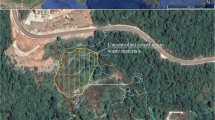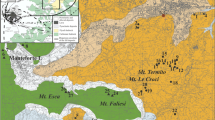Abstract
This case study paper is about a large rotational rock and earth slide—earth flow located in the Secchia River Valley, in the Northern Apennines of Italy, that has displayed multiple reactivation phases between 2002 and 2004. The main geological constraints of the mass movement are related to the overlap of flysch rock masses over clayey complexes that allows rock slides to take place in the source area. The disarrangement and weathering of rock masses following slope movements causes large amount of fine-grained debris to be accumulated on the slope and mobilised by earth sliding and flowing. Analysis of rainfall data at the onset of reactivation events has proved that they occurred after periods with cumulated values higher than the averages of the last 30 years. The quantification of the morphological modifications induced by these reactivations has been made possible by comparing pre- and post-event digital elevation models. Depletion and accumulation has been in the range of 30 m in different parts of the slope. In particular, an advancement of the landslide toe of more than 400 m, which caused a 30-m thick landslide tip to deposit, has been clearly seen. Monitoring data regarding subsurface movements and surface tension crack widening (tension cracks so large as to be properly described at trenches) has shown that sliding surfaces as deep as 43 m exist in the upper part of the landslide, while the accumulation lobe has moved by sliding and flowing over surfaces as deep as some 10 m. Velocities of cm/day have been recorded in the deep surfaces and in widening trenches of the source area, while the advancement of the accumulation lobe has been estimated as having velocities of up to 10 m/day. Groundwater in the landslide body has been observed at depths of 5–15 m in the upper areas, while it is estimated as being at the ground level in the toe. On this basis, it is concluded that the landslide still has a high potential for further development, both in the upper landslide zone and in the toe area.









Similar content being viewed by others
References
Bertolini G (2003) Frane e variazioni climatiche nell'Appennino emiliano. Unpublished PhD Thesis, Università degli Studi di Modena e Reggio Emilia, Modena
Bertolini G, Pellegrini M (2001) The landslides of Emilia Apennines (northern Italy) with reference to those which resumed activity in the 1994–1999 period and required civil protection interventions. In: Bertolini G, Pellegrini M, Tosatti G (eds) Le frane della Regione Emilia-Romagna, oggetto di interventi di Protezione Civile nel periodo 1994–1999, Quaderni di Geologia Applicata 8(1):27–74
Bettelli G, Panini F (1992) Nota illustrativa di una sezione geologica attraverso l'Appennino modenese. Studi Geologici Camerti 2:65–74
Bettelli G, Vannucchi P (2003) Structural style of off-scraped Ligurian oceanic sequences of the Northern Apennines: new hypothesis concerning the development of the mèlange block-in-matrix fabric. J Struct Geol 25:371–388
Bieniawski ZT (1989) Engineering rock mass classification, Wiley, New York
Bjerrum L (1967) Progressive failure in slopes of overconsolidated plastic clay and clay shales. J Soil Mech Found DivAm Soc Civil Eng 93:1–49
Borgefors G (1996) On digital distance transforms in three dimensions. Comput VisImage Underst 64(3):368–376
Cancelli A, Pellegrini M (1987) Deep-seated Gravitational Slope Deformations in the Northern Apennines, Italy. In: Proceedings 5th Intern. Conf. and Field Workshop on Landslides, Australia and New Zealand, pp 171–178
Castaldini D, Genevois R, Panizza M, Puccinelli A, Berti M, Simoni A (1998) An integrated approach for analysing earthquake-induced surface effects: a case study from the Northern Apennines, Italy. J Geodyn 26(2–4):413–441
Conti S, Tosatti G (1996) Tectonic vs. gravitational processes affecting Ligurian and Epiligurian Units in the Marecchia valley (Northern Apennines). Mem Sci Geol 48:107–142
Cruden DM, Varnes DJ (1996) Landslides types and processes. In: Turner AK, Schuster RL (eds) (1996) Landslides: investigation and mitigation. Transportation Research Board, Special Report 247, National Academy Press, Washington D.C., pp 36–75
Fazlagic S, Lombroso L, Quattrocchi S (2002) Osservazioni meteorologiche dell'anno 2002, con analisi dei casi di precipitazioni intense di breve durata. Atti Soc Nat Mat di Modena, 133:5–10
Fazlagic S, Lombroso L, Quattrocchi S (2004) Osservazioni meteorologiche 2004 a Modena e a Ferrara. Atti Soc Nat Mat di Modena 135:5–40
Garberi ML, Palumbo A, Pizziolo M with the contribution of Baldelli C, Barchiesi P, Bertolini G, De Nardo MT (1999) I numeri sulle frane. Regione Emilia-Romagna, Servizio Cartografico e Geologico, Bologna, Italy
Genevois R, Berti M, Ghirotti M, Romeo R, Simoni A (2000) Rapporti tra frane e sismi: risultati preliminari della ricerca nell'area appenninica centro-settentrionale. 1986–1995 Report, CNR-GNDCI Line 2, GNDCI Pubbl. 2142, pp 397–406
Hoek E, Brown ET (1997) Practical estimates of rock mass strength. Int J Rock Mech Mining Sci& Geomechan Abs 34(8):1165–1186
Hungr O, Evans SG, Bovis MJ, Hutchinson JN (2001) A review of the classification of landslides of the flow type. Environ Eng Geosci 7:221–238
Hutchinson JN (1986) A sliding-consolidation model for flow slides. Can Geotech J 23:115–126
Hutchinson JN, Bhandari RH (1971) Undrained loading, a fundamental mechanism of mudflows and other mass movements. Geotechnique 21:353–358
Krahn J (2004) Stability modeling with SLOPE/W. An engineering methodology GEO-SLOPE/W International, Ltd. Calgary, Alberta, Canada
Larini G, Marchi G, Pellegrini M, Tellini C (1997) La grande frana di Corniglio (Appennino sttentrionale, Provincia di Parma) riattivata negli anni 1994–1996. In: Proceedings of the International Conf. La Prevenzione delle Catastrofi Idrogeologiche: il Contributo della Ricerca Scientifica, CNR-IRPI Torino, 5–7 November, Alba, pp 1–12
Lollino G, Brunamonte F, Larini G, Malaguti C (2001) La sperimentazione del Sistema Inclinometrico Automatizzato nel monitoraggio continuo della frana di Corniglio (Parma) e ricerca di correlazioni significative fra le precipitazioni e la riattivazione del novembre 1994. In: Bertolini G, Pellegrini M, Tosatti G (eds) (2001) Le frane della Regione Emilia-Romagna, oggetto di interventi di Protezione Civile nel periodo 1994–1999 Quaderni di Geologia Applicata 8(2):159–187
Marinos P, Hoek E (2001) Estimating the geotechnical properties of heterogeneous rock masses such as flysch. Bull Eng Geol Env 60:85–92
Matthews JA, Brunsden D, Frenzel B, Gläser B, Weiß MM (eds) (1997) Rapid mass movement as a source of climatic evidence for Holocene. Paläoklimaforschung—Palaeoclimate Research, 19
Mazzini E (1995) Alcuni casi di franamento indotti nel versante appenninico emiliano dal terremoto della Garfagnana del 7 settembre 1920. Possibili indicatori paleosismici? Quaderni di Geologia Applicata 2:139–146
Regione E-R (1982) Carta geologica dell'Appennino emiliano-romagnolo 1: 10.000. Resp. Pignone R, Ed. SELCA, Firenze
Sassa K (1984) The mechanisms starting liquefied landslides and debris flows. Proc 4th Int Symp Landslides, Toronto, 2:349–354
Soldati M, Corsini A, Pasuto A (2004) Landslides and climate change in the Italian Dolomites since the Lateglacial. Catena 55(2):141–161
WP/WLI Working Party on the World Landslide Inventory & Canadian Geotechnical Society (1993) Multilingual landslide glossary. BiTech Publishers, Richmond, B.C.
Acknowledgements
The authors are indebted to Maurizio Pellegrini for his strong support and the stimulating discussions on landsliding mechanisms and to Giuseppe Bettelli for his precious hints on the geological background. The authors also wish to acknowledge Maia Laura Ibsen for the final editing of English language and Luca Lombroso and Salvatore Quattrocchi (Osservatorio Geofisico, Modena and Reggio Emilia University) for providing unpublished data on the snow cover. Geognostic and monitoring data have been collected by Servizio Tecnico dei Bacini Enza e sinistra Secchia of Regione Emilia-Romagna, in the frame of the Intervention Plan supported by Ordinanza del Presidente del Consiglio dei Ministri n. 3357/2004 and Decreto del Presidente del Consiglio dei Ministri 08/07/2004 concerning “Movimenti franosi verificatesi nei Comuni di Baiso e Canossa nel febbraio 2004”. Distinct contribution of the authors: Lisa Borgatti and Alessandro Corsini have conceived and written the paper, and have elaborated most of the figures and tables together with Massimo Barbieri, who also performed differential DEM analysis. Gaetano Sartini, Giovanni Truffelli and Giuseppe Caputo have planned and managed geognostic investigation and monitoring. Claudio Puglisi has carried out restitution of contour lines from 2004 aerial photographs
Author information
Authors and Affiliations
Corresponding author
Rights and permissions
About this article
Cite this article
Borgatti, L., Corsini, A., Barbieri, M. et al. Large reactivated landslides in weak rock masses: a case study from the Northern Apennines (Italy). Landslides 3, 115–124 (2006). https://doi.org/10.1007/s10346-005-0033-9
Received:
Accepted:
Published:
Issue Date:
DOI: https://doi.org/10.1007/s10346-005-0033-9




